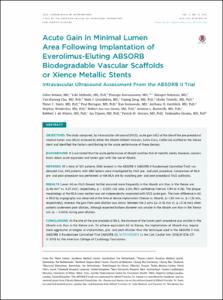KUMEL Repository
1. Journal Papers (연구논문)
1. School of Medicine (의과대학)
Dept. of Internal Medicine (내과학)
Acute Gain in Minimal Lumen Area Following Implantation of Everolimus-Eluting ABSORB Biodegradable Vascular Scaffolds or Xience Metallic Stents: Intravascular Ultrasound Assessment From the ABSORB II Trial.
- Keimyung Author(s)
- Cho, Yun Kyeong
- Department
- Dept. of Internal Medicine (내과학)
- Journal Title
- JACC Cardiovascular Interventions
- Issued Date
- 2016
- Volume
- 9
- Issue
- 12
- Abstract
- OBJECTIVES The study compared, by intravascular ultrasound (IVUS), acute gain (AG) at the site of the pre-procedural
minimal lumen area (MLA) achieved by either the Absorb (Abbott Vascular, Santa Clara, California) scaffold or the Xience
stent and identified the factors contributing to the acute performance of these devices.
BACKGROUND It is warranted that the acute performance of Absorb matches that of metallic stents; however, concern
exists about acute expansion and lumen gain with the use of Absorb.
METHODS Of a total of 501 patients (546 lesions) in the ABSORB II (ABSORB II Randomized Controlled Trial) randomized
trial, 445 patients with 480 lesions were investigated by IVUS pre- and post-procedure. Comparison of MLA
pre- and post-procedure was performed at the MLA site by matching pre- and post-procedural IVUS pullbacks.
RESULTS Lower AG on IVUS (lowest tertile) occurred more frequently in the Absorb arm than in the Xience arm
(3.46 mm2 vs. 4.27 mm2, respectively; p < 0.001; risk ratio: 3.04; 95% confidence interval: 1.94 to 4.76). The plaque
morphology at the MLA cross-section was not independently associated with IVUS acute gain. The main difference in AG
in MLD by angiography was observed at the time of device implantation (Xience vs. Absorb, Dþ1.50 mm vs. Dþ1.23 mm,
respectively), whereas the gain from post-dilation was similar between the 2 arms (Dþ0.16 mm vs. Dþ0.16 mm) when
patients underwent post-dilation, although expected balloon diameter was smaller in the Absorb arm than in the Xience
arm (p ¼ 0.003) during post-dilation.
CONCLUSIONS At the site of the pre-proceduralMLA, the increase of the lumen post-procedure was smaller in the
Absorb-arm than in the Xience arm. To achieve equivalent AG to Xience, the implantation of Absorb may require
more aggressive strategies at implantation, pre- and post-dilation than the technique used in the ABSORB II trial.
- Keimyung Author(s)(Kor)
- 조윤경
- Publisher
- School of Medicine
- Citation
- Yohei Sotomi et al. (2016). Acute Gain in Minimal Lumen Area Following Implantation of Everolimus-Eluting ABSORB Biodegradable Vascular Scaffolds or Xience Metallic Stents: Intravascular Ultrasound Assessment From the ABSORB II Trial. JACC Cardiovascular Interventions, 9(12), 1216–1227. doi: 10.1016/j.jcin.2016.03.022
- Type
- Article
- ISSN
- 1936-8798
- Appears in Collections:
- 1. School of Medicine (의과대학) > Dept. of Internal Medicine (내과학)
- 파일 목록
-
-
Download
 oak-2016-0010.pdf
기타 데이터 / 2.38 MB / Adobe PDF
oak-2016-0010.pdf
기타 데이터 / 2.38 MB / Adobe PDF
-
Items in Repository are protected by copyright, with all rights reserved, unless otherwise indicated.